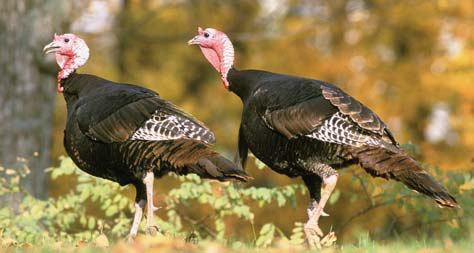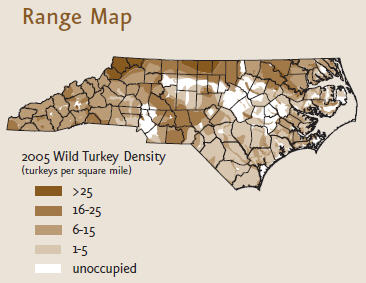
Classification
Class: Aves
Order: Galliformes
Average Size
Height: 3-4 ft.
Wingspread: 4-5 ft.
Weight: Female 10.0 lbs; male 17.5 lbs.
Food
Seeds, grasses, acorns, nuts, berries, insects.
Breedin

g
Males are called gobblers or toms; females are called hens. Males attract females by gobbling and strutting.
Young
Very young turkeys are called poults. Juvenile females are called jennies; juvenile males are jakes.
Wild turkeys lay eggs beginning in April. Average clutch size is about 8–15 eggs. Average of one clutch per year, but females will renest if the first clutch
fails. Young are sexually mature in one year.
Life Expectancy
Two years, although some birds have lived up to 10 years.

Range and Distribution
The wild turkey is found in 49 of the United States, in Mexico, and in parts of Canada. Only Alaska has no wild turkeys. North Carolina’s turkey restoration program was a monumental success, and turkeys are now found throughout North Carolina from the mountains to the coast. The range of the wild turkey continues to expand as remaining areas with suitable habitat are occupied by dispersing turkey populations. Note that it is illegal to release pen-raised turkeys in the wild because of the danger of introducing diseases to healthy wild birds.
General information
Wild turkeys were important both to American Indians and early Europeans in America. For Plains and Eastern Indians, turkeys were an important food source and provided feathers for head dressings and arrows. Indians also used turkey spurs to make arrow points and other sharp utensils. Early Europeans used wild turkeys as a food source. However, believe it or not, historians are unsure if wild turkeys were served to the Pilgrims on our country’s first Thanksgiving. Ben Franklin considered the wild turkey a better symbol for the United States than the bald eagle because he felt the wild turkey was a more respectable bird.
Two species of wild turkeys are found in North America: Meleagris gallopavo and Meleagris ocellata (the ocellated turkey). Only Meleagris gallopavo is found in the United States. The Osceola, Gould’s, Rio Grande, Merriam’s and eastern wild turkeys are all subspecies of this species. The eastern wild turkey is the only subspecies found in North Carolina.
History and status
When early European settlers arrived in America turkeys were plentiful in North Carolina and were probably found throughout the entire state. By the turn of the century, however, few turkeys remained.
The decline was primarily due to unregulated and heavy market hunting, rapid deforestation and habitat destruction throughout the state. This decline continued into the 1960s. Turkeys are once again common in North Carolina, thanks to a restoration program implemented by the N.C. Wildlife Resources Commission that involved live-trapping and relocating wild turkeys from sites in North Carolina and other states to areas in the state where the bird had previously disappeared. From the 1950s through 2005, over 6,000 wild turkeys were trapped and relocated to 358 release sites across the state. Since restoration efforts have begun, North Carolina’s population has jumped from 2,000 birds in 1970 to over 150,000 in 2009. Wild turkey populations are still growing in many portions of the state.

Description
The wild turkey is omnivorous, feeding primarily on nuts, berries, acorns, grasses, seeds and insects. The turkey will also eat almost any small creature it encounters, such as lizards or grubs.
The male eastern wild turkey has dark plumage with striking bronze, copper and green iridescent colors. On the inside of their legs, males have pointed growths known as spurs that they use when battling other males for mates. Males also have a growth of bristle-like feathers known as the “beard” that extends from the chest. It is not uncommon, however, to find females with a beard. The head and neck of adult males is largely bare and varies in color from red to blue to white, depending on the bird’s mood. Females are usually duller in color than males, which help camouflage them while they are nesting. Turkeys primarily rely on their eyesight and hearing for protection from predators. Their excellent eyesight is their best defense during the daytime, but they don’t see well at night. As with most birds, turkeys have little or no sense of smell. Turkeys are highly mobile and can run up to 25 mph and fly up to 55 mph.

Habitat and habits
The eastern wild turkey thrives best in areas with a mix of forested and open land habitats. Forested areas are used for cover, foraging, and for roosting in trees at night. Open land areas are used for foraging, mating, and brood rearing. Turkeys nest on the ground with clutches of 10-14 eggs being laid from mid-April through mid-May in North Carolina. Turkeys are very vocal birds, and they communicate by means of a variety of calls. During the spring mating season, gobblers use their booming gobble to attract hens.
People interactions
The wild turkey remains a favorite game animal for recreational hunters. Its meat is quite lean and delicious, though sometimes tough in older birds. Although commercial and unregulated hunting were problems in the past, hunters were the main group that helped restore turkey populations by funding restocking and relocating programs and by contributing to groups that conserve habitat such as the National Wild Turkey Federation.
NCWRC Interaction: How You Can Help
A wild turkey brood survey is conducted each summer to gain insight into wild turkey productivity across the state and to evaluate gobbler harvest levels from the previous spring hunting season. Participants in the survey primarily consist of N. C. Wildlife Resources Commission employees and avid hunters. Participation in the survey simply involves keeping track of wild turkey observations during the course of routine, daily activities from July 1 through August 31. In you are a licensed hunter and would like to participate in the summer turkey brood survey, submit the WRC # from your hunting license and your name, mailing address and date of birth to:
NCWRC
Division of Wildlife Management
1722 Mail Service Center
Raleigh, NC 27699-1722.
